Exam Details
Exam Code
:JN0-663Exam Name
:Service Provider Routing and Switching, Professional (JNCIP-SP)Certification
:Juniper CertificationsVendor
:JuniperTotal Questions
:96 Q&AsLast Updated
:Mar 25, 2025
Juniper Juniper Certifications JN0-663 Questions & Answers
-
Question 51:

R1 assigns incoming voice traffic to the ef forwarding class. All other traffic is assigned to the best-effort forwarding class. You have configured a CoS re-write rule on R1 to include the correct CoS bit values in packets sent towards R2. You want R2 to classify traffic using the CoS markings created by R1.
Which two configuration steps are necessary to accomplish this task? (Choose two.)
A. Assign the behavior aggregate classifier to the ge-0/0/1.0 interface on R2.
B. Assign the CoS re-write rule to the ge-0/0/1.0 interface on R2.
C. Configure a CoS re-write rule on R2 and assign matching CoS values.
D. Configure a behavior aggregate classifier on R2.
-
Question 52:
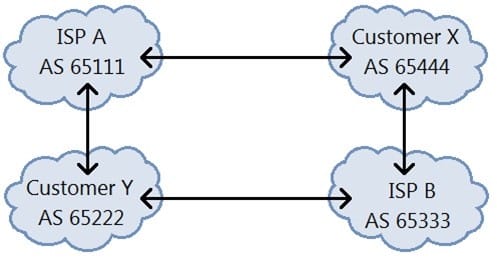
All networks shown in the exhibit contain more than one BGP speaker. You operate ISP A and must ensure that Customer Y sends their traffic to you over the directly connected link. Customer Y is not to be used for transit into your network.
What would you do to accomplish this task?
A. Advertise routes to Customer X with the custom defined 0:0 community.
B. Advertise routes to Customer X with the well-known no-advertise community.
C. Advertise routes to Customer Y with the custom defined 65535:65535 community.
D. Advertise routes to Customer Y with the well-known no-export community.
-
Question 53:

Referring to the exhibit, you need to implement VPLS between CE-A1 and CE-A2. You must ensure that no loops are created due to the multihoming of the connection from CE-A2 to PE2 and PE3.
Based on the type of VPLS, which two solutions will satisfy this requirement? (Choose two.)
A. In an LDP VPLS, configure a primary and backup neighbor.
B. In an LDP VPLS, configure multihoming and local preference on PE-2 and PE-3.
C. In a BGP VPLS, configure multihoming and local preference on PE-2 and PE-3.
D. In a BGP VPLS, configure a primary and backup neighbor.
-
Question 54:
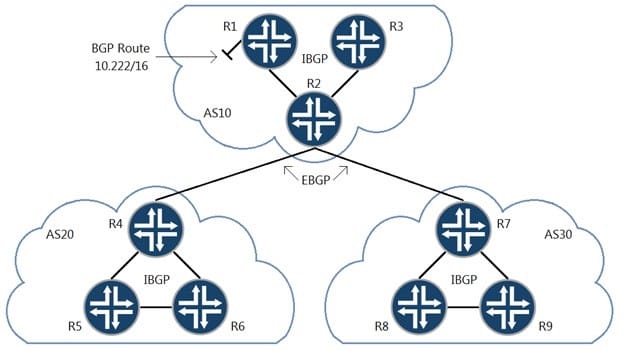
Referring to the exhibit, which three statements about route 10.222/16 are correct when using the default BGP advertisement rules? (Choose three)
A. R1 will prepend AS10 when advertising 10.222/16 to R2.
B. R2 will prepend AS10 when advertising 10.222/16 to R7.
C. R2 will advertise 10.222/16 to R4 with itself as the next hop.
D. R1 will advertise 10.222/16 to R2 with itself as the next hop.
E. R7 will advertise 10.222/16 to R9 with itself as the next hop.
-
Question 55:
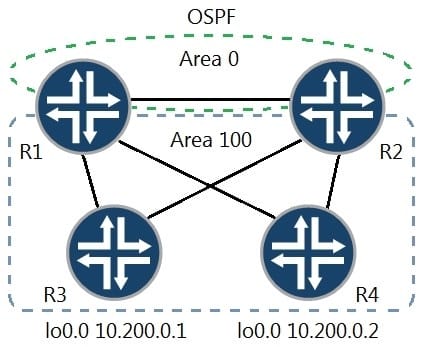
Traffic is being sent from R2 to R3. The link between R2 and R3 fails. Referring to the exhibit, which statement is correct?
A. Traffic will automatically reroute using the shortest path, which is R2 to R1 to R3.
B. Traffic will automatically reroute distributed between all available paths.
C. Manual intervention is required for traffic to be rerouted.
D. Traffic will automatically reroute using R2 to R4 to R1 to R3.
-
Question 56:

You have an established Layer 3 VPN between two PE devices. You are asked to only send certain routes from PE-1 over the VPN to the remote site while maintaining all the routes on the PE-1 device. You created a policy that matches the specific routes and then tags these routes with the appropriate target community values.
In this scenario, which configuration changes must be made to satisfy the requirement?
A. Configure the export parameter and apply the policy to the my-ext-group BGP group configuration.
B. Configure the vrf-export parameter and apply the policy under the edit routing-instances vpn-a hierarchy.
C. Configure a RIB group and apply the policy as an import policy to routes distributed into the bgp.13vpn.0 routing table.
D. Configure the import parameter and apply the policy to the my-ext-group BGP group configuration.
-
Question 57:
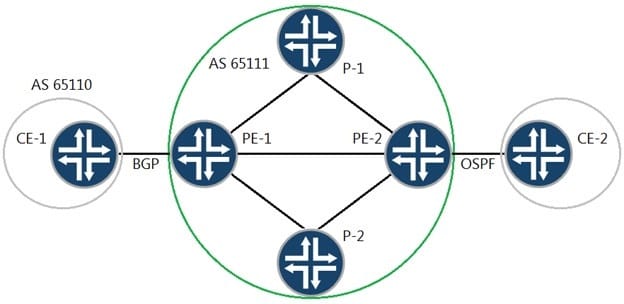
You have a Layer 3 VPN established between PE-1 and PE-2 to allow communication between CE-1 and CE-2.
Referring to the exhibit, which statement is correct?
A. You will need an OSPF import policy on PE-1 to receive the BGP routes, learned from PE-2, through the Layer 3 VPN.
B. You will need a BGP export policy on PE-1 to redistribute the routes, learned from CE-1, through the Layer 3 VPN.
C. You will need a VRF import policy on PE-1 to advertise the BGP routes, learned from CE-1, through the Layer 3 VPN.
D. You will need an OSPF export policy on PE-2 to redistribute the BGP routes, learned from PE-1, through the Layer 3 VPN.
-
Question 58:

R2 is receiving a route from an EBGP neighbor and is advertising the route to R4.
Referring to the exhibit, which configuration on R2 will solve the issue with the route on R4?
A. Move the no-advertise export policy from group 65002 to a global BGP policy.
B. Move the nhs policy from a global BGP export policy to an export policy under group 65002.
C. Move the no-export policy from a global BGP import policy to an import policy under group 65001.
D. Move the no-advertise export policy from group 65001 to a global BGP policy.
-
Question 59:
Which two statements regarding Ethernet segments (ES) are correct? (Choose two.)
A. The Type-4 EVPN route will be used to elect the designated forwarder for the ES.
B. The Type-3 EVPN route will be used for the aliasing function to load-balance to the ES.
C. The Type-1 EVPN route will indicate if the ES is all-active or single-active.
D. The Type-2 EVPN route will indicate if there is a designated forwarder on the ES.
-
Question 60:
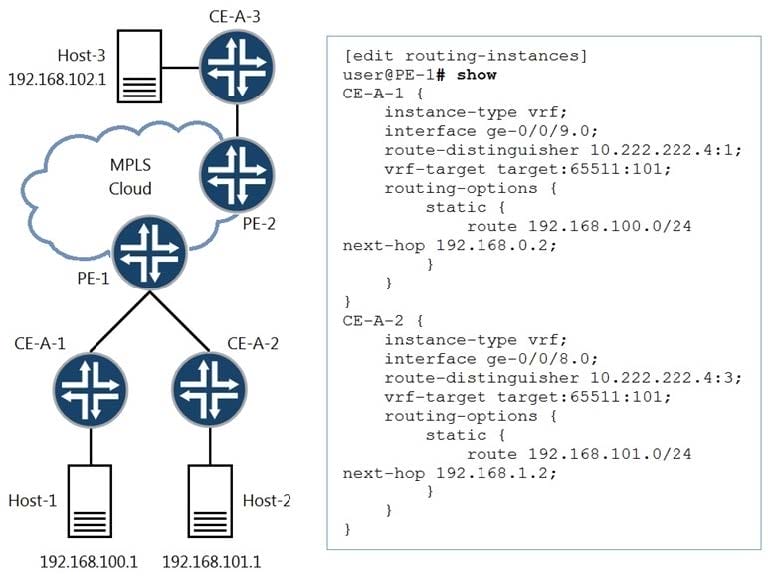
Referring to the exhibit, there is a Layer 3 VPN setup that connects sites CE-A-1, CE-A-2, and CE-A-3 together. Host-1 can communicate with Host-3, but Host-1 cannot communicate with Host-2.
What must you do to solve the problem?
A. Change the route distinguisher in both routing instances to the same value.
B. Use the next-table configuration statement for static routes in the corresponding routing instances.
C. Use BGP instead of static routing between the CE and PE devices.
D. Use the auto-export command in both routing instances.
Related Exams:
JN0-102
Internet Associate, Junos(JNCIA-Junos)JN0-104
Junos, Associate (JNCIA-Junos)JN0-105
Junos, Associate (JNCIA-Junos)JN0-1101
Juniper Networks Certified Design Associate (JNCDA)JN0-130
Juniper networks Certified internet specialist.e(jncis-e)JN0-1301
Data Center Design, Specialist (JNCDS-DC)JN0-1302
Data Center Design Specialist (JNCDS-DC)JN0-1331
Security Design, Specialist (JNCDS-SEC)JN0-1332
Security Design, Specialist (JNCDS-SEC)JN0-1361
Service Provider Design Specialist (JNCDS-SP)
Tips on How to Prepare for the Exams
Nowadays, the certification exams become more and more important and required by more and more enterprises when applying for a job. But how to prepare for the exam effectively? How to prepare for the exam in a short time with less efforts? How to get a ideal result and how to find the most reliable resources? Here on Vcedump.com, you will find all the answers. Vcedump.com provide not only Juniper exam questions, answers and explanations but also complete assistance on your exam preparation and certification application. If you are confused on your JN0-663 exam preparations and Juniper certification application, do not hesitate to visit our Vcedump.com to find your solutions here.